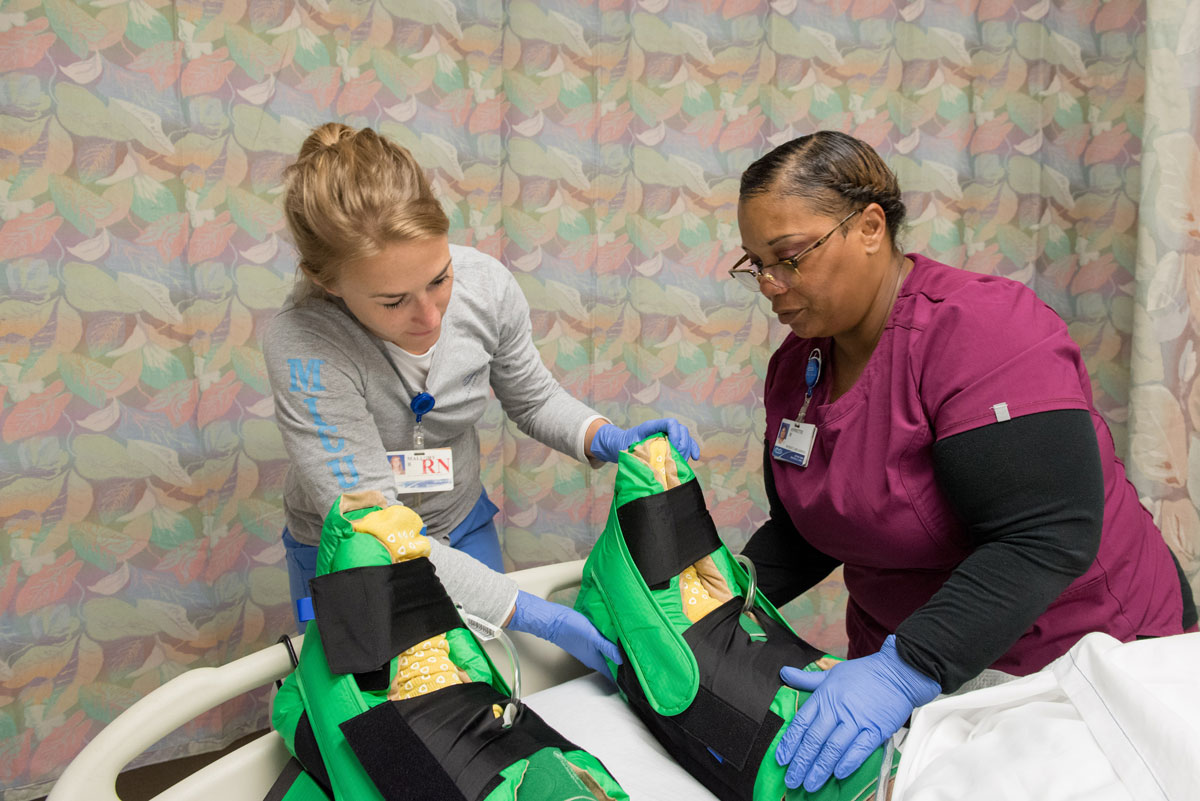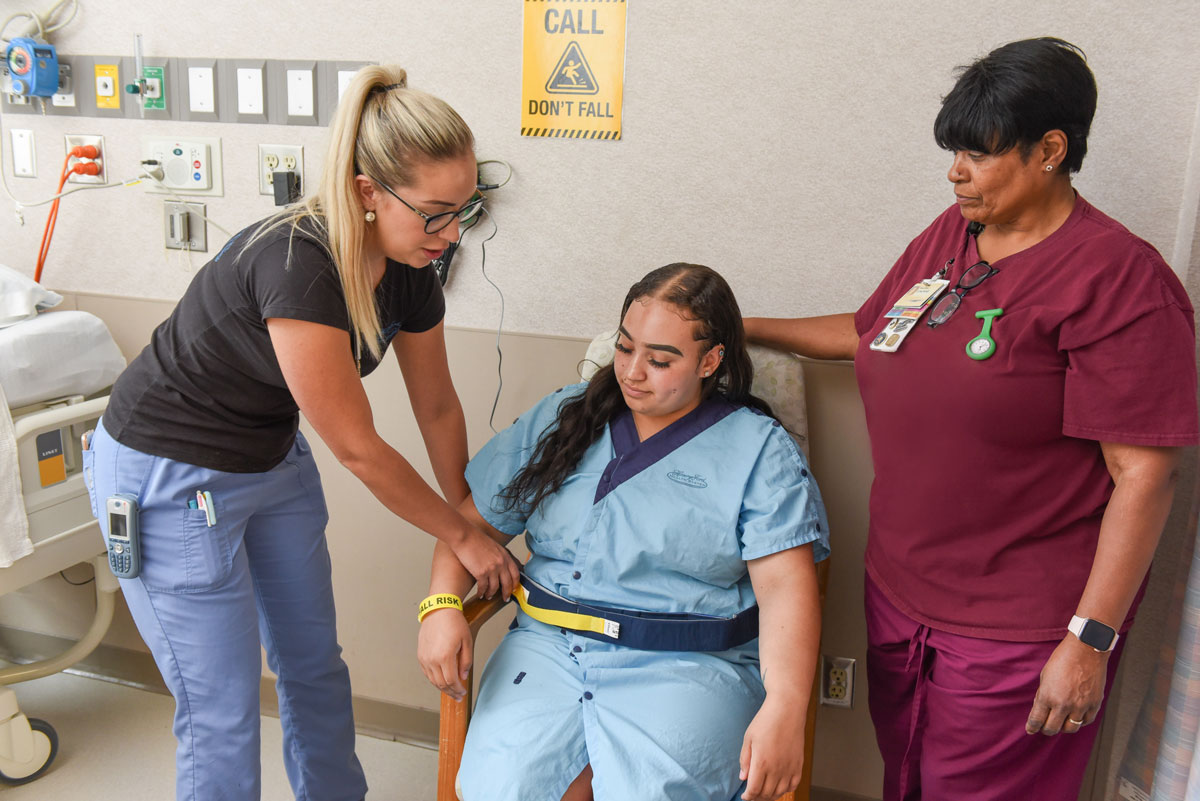Empirical Outcomes
 Henry Ford Hospital (HFH) nurses take patient safety and quality seriously. Our professional practice is based on achieving optimal patient outcomes by always striving to improve.
Henry Ford Hospital (HFH) nurses take patient safety and quality seriously. Our professional practice is based on achieving optimal patient outcomes by always striving to improve.
Through our commitment to empirical outcomes, we have made great improvements in nurse and patient satisfaction as well as in clinical outcomes. Dedicated Henry Ford nurses strive to create an environment of evidence-based care, clear clinical guidelines, documentation and measurement.
CLABSI
Interprofessional team takes action
In January 2019, Henry Ford Hospital (HFH) introduced a new blood culture system with greater sensitivity. As a result, more patients were identified with Central Line Blood Stream Infections (CLABSI).
 Medical ICU Clinical Nurse Specialist Stephanie Schuldt, MN, RN, CCRN-K, CCNS, ACNS-BC, has been involved in helping with the new system and eliminating CLABSI.
Medical ICU Clinical Nurse Specialist Stephanie Schuldt, MN, RN, CCRN-K, CCNS, ACNS-BC, has been involved in helping with the new system and eliminating CLABSI.
“Since the new process is more sensitive, more attention has been drawn to CLABSI prevention. We have developed blood culture guidelines and increased education to improve the culturing practices,” Schuldt explained.
An interprofessional team has been meeting regularly to review the Root Cause Analysis (RCA) for each CLABSI. Nursing leaders have been given protected time to round and conduct daily central line audits and hand hygiene observations to provide feedback and education to front line staff in real time.
Additional improvements were made to the device audit tool, including adding questions about Chlorhexidine Gluconate (CHG) treatments (baths) and the presence of Clear Guard Caps.
Initial education has focused on these five areas of nursing practice.
- Daily efforts for central line removal and removal of multiple lines.
- Curos caps on central line tubing, dressing clean and intact.
- “Scrub the Hub” any time an IV is accessed.
- Daily CHG treatments for all central line patients, and all ICU patients.
- Eliminating draws from central lines for blood cultures.
CAUTI
First step…Get rid of the Foley

The Henry Ford Hospital (HFH) Catheter Associated Urinary Tract Infection (CAUTI) prevention team all agree that decreasing the use of Foley catheters is imperative in decreasing infections.
The team is made up of clinical nurses, nursing leaders, advanced practice providers and physicians who work hard to reduce the chances of CAUTIs at HFH. Over the last two years they have made great progress related to education, equipment and process changes.
It takes the entire team working collaboratively to prevent CAUTIs. During daily progression rounds, the need for a Foley catheter is discussed with the goal of early removal. The Emergency Department and Post Anesthesia Care Unit also work with the inpatient units to assist in CAUTI prevention through early removal initiatives.
To proactively look for the best ways to stop CAUTIs, the prevention team uses a group of evidence-based practice known as the Foley bundle. The Foley bundle audits are conducted bi-monthly and are analyzed by the prevention team.
HFH Nurse Administrator Susan Klotz MS, RN, RNC-OB understands the importance for Foley catheter education.
“I have been working with the clinical nurses to review Foley insertion techniques since multiple units have less insertion opportunities,” Klotz explains. “Urinary retention after Foley removal is also very important and is something we need to keep talking about.”
In addition, the prevention team meets monthly to review the Root Cause Analysis (RCA) for each CAUTI. More details have been added to the RCA tool for CAUTIs, including Foley Bundle compliance, reason for urinary culture, catheter and peri care completion, and whether a second person assisted with insertion of the catheter.
Moving forward, the primary focuses are finding alternatives to Foley use and quick removal when used. The biggest way to achieve this goal is reinforcement of the nurses’ ability to remove Foleys by using the nurse-driven Foley catheter removal protocol.
HAPI
Process, products, innovation

Since 2017, the Henry Ford Hospital (HFH) Pressure Injury Reduction Team has focused on education, process change and new products to decrease the number of hospital-associated pressure injuries (HAPI).
Clinical Nurse Specialists Cathy Draus DNP, ACNS-BC and Cathy Jackman MSN, RN, ACNS-BC continue to work with the team to decrease HAPI.
Changes in documentation and policy updates that require a two-person assessment were made to help identify pressure injuries that are present on admission. A guideline reference link was added in EPIC and a pressure injury treatment options guide was posted on all units.
An additional process change was made to add real-time “Turn and Float” audits to reinforce key interventions. The audits are completed bi-monthly by team members with immediate feedback. The audit consists of identifying five patients with the lowest Braden score on each unit and assessing position changes and floatation of heels. After three hours the team members return and reassess the patient.
MICU Pods 1 and 2 are piloting a product called LEAF, a sensor button placed on the patient’s gown that measures body movement indicating when the patient needs to be turned.
"We are shaking the tree, so to speak, to see what else is new and trying to look outside of the box,” said Jackman. “These innovative changes help our patients in new ways.”
The Wound Care team’s “UNHAPI Hank” project is providing units with real time data on patient harm. UNHAPI Hank, a poster representing the human body, is being piloted on three units. When a pressure injury is identified the nurse places a sad face on the poster representing the location of the patient’s pressure injury.
“The goal of this project is to increase awareness and accountability, while providing early indication of pressure injury patterns,” said Jackman. “It helps staff to visualize the amount of HAPIs on the unit.”
Falls with injury
Sustaining progress

In August 2018, Henry Ford Hospital (HFH) implemented the Hester Davis (HD) Falls Program. Seven months later, HFH was seeing great improvements and was below the National Database of Nursing Quality Indicators® (NDNQI) target for falls with injury. Success continues to grow as year to date comparison of falls and falls with injury continue to show significant improvement in both categories.
Nurse Administrator Denise Robinson, MSN, MBA, RN led the health system in fully implementing and executing this program. She has worked diligently with the goal of reaching zero falls with injury.
After implementing HD, problems with the care plan were identified by the clinical nurses. A group of nurses collaborated with the Epic Helios team to develop a more streamlined plan of care.
An integral part of HD is fall mats which proved to be a major shift in process and work flow on the units. The mats are placed at the patient’s bedside so if a fall happens, the mat provides extra cushion to help avoid injuries.
“The biggest challenge was to start using fall mats,” says Robinson. “They can be cumbersome, take up a lot of space and team members worried about tripping on them. However, we hear stories of patients who have fallen on mats and not sustained injuries which has helped everyone see the value.”
The B5 Neuroscience unit has played a large role in the program and is piloting different pieces to help with its success. In addition to pilots, B5 Neuroscience Unit Nurse Manager Jason Thompson BSN, RN and I6 Stroke Unit Clinical Nurse Specialist Lisa Cohen MSN, RN, ACNS-BC developed a comprehensive nurse assistant (NA) education plan to focus on high risk activities related to falls.
According to Thompson, “Nursing assistants are key team members when it comes to preventing falls and fall related injuries.”
B5 is piloting the Posey belt and “Call Don’t Fall” signs in patient rooms. The belt wraps around the patient and the chair to provide an alarm that will allow the caregiver additional time to arrive and prevent a possible fall. The signs then remind patients of the importance of asking for assistance to prevent falls.
The comprehensive team approach to the HD program has ensured its success at HFH and team members are continuing to work hard towards the goal of zero falls with injury.
Next Section: Transformational Leadership >>
.svg?iar=0&hash=F6049510E33E4E6D8196C26CCC0A64A4)

/hfh-logo-main--white.svg?iar=0&hash=ED491CBFADFB7670FAE94559C98D7798)